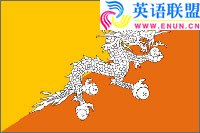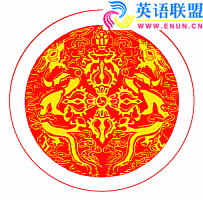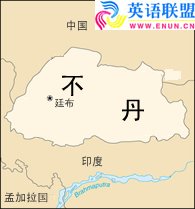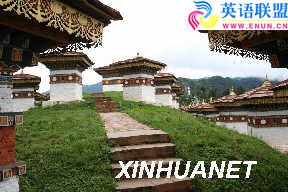 国名: 不丹王国(Kingdom of Bhutan)
国名: 不丹王国(Kingdom of Bhutan)
国庆日:12月17日(1907年)
国旗:呈长方形,长与宽之比为3∶2。由金黄色和桔红色的两个直角三角形组成,中间一条白色的飞龙,四个爪子各抓一颗白而亮的宝珠。金黄色象征国王的权力和作用;桔红色是僧侣长袍的颜色,象征佛教的精神力量;龙象征国家权力,又指这个国家的名字,因为不丹可译为“神龙之国”。龙爪上握有白珠,象征威力和圣洁。 
国徽:呈圆形。圆面上两条龙腾空而起,象征权力和尊严。龙的周围是燃烧的火焰,圆面中心是十字形图案,它是大自然雷电霹雳的象征。圆面外圈的白色圆环的上部,用藏文书写着“光荣的不丹是不可战胜的”。
 自然地理:面积3.8万平方公里。位于喜马拉雅山脉东段南坡,其东、北、西三面与中国接壤,南部与印度交界,为内陆国。北部山区气候寒冷,中部河谷较温和,南部丘陵平原属湿润的亚热带气候。国土面积的74%为森林所覆盖,其中有26%的地区被划定为保护地。
自然地理:面积3.8万平方公里。位于喜马拉雅山脉东段南坡,其东、北、西三面与中国接壤,南部与印度交界,为内陆国。北部山区气候寒冷,中部河谷较温和,南部丘陵平原属湿润的亚热带气候。国土面积的74%为森林所覆盖,其中有26%的地区被划定为保护地。
人口:约73万。不丹族占80%,其余为尼泊尔族等。西部不丹语言“宗卡”和英语为官方用语,南部操尼泊尔语。藏传佛教(噶举派)为不丹的国教。
国家元首:国王 凯萨尔·旺楚克,2006年12月继承王位。  旺楚克王朝第四代国王吉格梅·辛格·旺楚克
旺楚克王朝第四代国王吉格梅·辛格·旺楚克
|
|
|
篮球是不丹年轻人特别 |
首都:廷布 (Thimphu) 是全国的政治、宗教中心。地处喜马拉雅山南麓,旺河从城市穿过。城市海拔2500多米,人口约5万(2002年)。
行政区划: 全国划分为4个行政区、20个宗(县)。
简史:9世纪不丹为独立部落。1772年英国侵犯不丹。1865年11月,英国同不丹签订了《辛楚拉条约》,强迫不丹割让包括噶伦堡在内的第斯泰河以东约2000平方公里的地区。1907年建立不丹王国,乌颜·旺楚克成为世袭国王。1910年1月,英国和不丹又签订了《普那卡条约》,规定不丹对外关系接受英国的“指导”,1949年8月,印度和不丹签订《永久和平与友好条约》,规定不丹对外关系接受印度的“指导”。1971年,成为联合国成员国。  不丹:最后的“香格里拉” 最后的君王 探访不丹 不丹青山绿水间的古朴民风 “小国寡民”不丹,“幸福”的国民只关注幸福 在不丹体会“国民幸福总值”
不丹:最后的“香格里拉” 最后的君王 探访不丹 不丹青山绿水间的古朴民风 “小国寡民”不丹,“幸福”的国民只关注幸福 在不丹体会“国民幸福总值”
|
|
|
不丹故都普那卡宗的农田村舍 |
政治:不丹历史悠久。现在的旺楚克王朝建立于1907年,实行世袭君主制,没有宪法和政党。1953年,不丹建立立法机构国民议会,负责制定法律,对重大问题进行讨论和决策。1968年5月,不丹建立最高行政机构大臣委员会,行使政府内阁职能,国王兼任政府首脑。1972年,时年16岁的吉格梅·辛格·旺楚克登基,成为旺楚克王朝第四位国王。为向现代化国家转变,旺楚克国王决意改变传统的世袭君主制,在不丹推行民主制。1998年6月,旺楚克国王解散内阁,对政治体制进行重大改革,国王不再兼任政府首脑,将政府管理权移交给大臣委员会。2001年9月,旺楚克国王下令筹备起草宪法,以结束世袭君主制,建立议会民主制国家。同年11月30日,宪法起草委员会成立。2005年3月,宪法起草委员会向社会公布第四稿宪法草案,请全国人民讨论。草案在形成全国共识后,经国民议会审批,成为不丹正式宪法。根据这部宪法,不丹将建立两院议会制。2006年12月,旺楚克国王将王位传给他的儿子吉格梅·凯萨尔·纳姆耶尔·旺楚克。新国王登基后继续推进不丹的民主政治进程。2007年12月,不丹选举产生议会上院。2008年3月,不丹举行国民议会(下院)选举,将首次通过选举产生议会民主制下的政府。根据不丹宪法,在国民议会选举结束并成立新的政府后,国王是不丹的国家元首,而议会在三分之二多数的支持下可以弹劾国王。>>
经济:不丹王国政府致力于实现国家的现代化,2005年人均收入达712美元,在南亚各国中是比较高的。发展经济的同时,不丹重视保护环境和生态资源,每年只允许6000名外国游客入境旅游,而且他们的行程还必须经不丹政府的仔细审核。为表彰不丹国王和人民在环保领域的突出贡献,联合国将联合国首届“地球卫士奖”授予了旺楚克和不丹人民。
|
|
|
不丹多久拉山口的108塔 |
新闻出版:不丹政府设有不丹新闻与广播机构,负责对全国的广播、电视事务。1973年,不丹成立广播公司,用不丹语、英语、尼泊尔语等广播。1999年,不丹广播公司开通电视服务。《昆色尔》为不丹发行量最大的报纸。1999年,不丹建成全国计算机互联网。
外交:不丹同中国虽未建交,但两国关系友好。1984年起中不边界会谈每年一次,轮流在北京与廷布举行。
National Day: December 17 (1907)
Flag: a rectangular, long and wide ratio of 3:2. From the yellow and orange of the two right triangle composed of a white middle of the dragon, all four claws grasping a white and bright Baozhu. Gold symbol of the king's power and role of orange is the color of monks robes, symbolic of the Buddhist spiritual strength; dragon symbol of state power, also said that the country's name, because Bhutan can be translated as "Dragon of the country." Long Zhao hold on the white beads, the symbol of power and sanctity.
The national emblem: a circle. Round two surface-into the sky, symbolizing the power and dignity. Long around the flame burning, with a round face centre is cruciform pattern, it is a symbol of nature lightning Perak. A round face and white outer ring of the upper ring, and possession of instruments said "the glorious Bhutan is invincible."
Physical Geography: 38,000 square km area. Located in the eastern section of the southern slope of the Himalayas, East, North, West and three bordering China, the southern border with India, for landlocked countries. The mountains north of the cold climate, the more moderate Central Valley, south of the hilly plains of humid subtropical climate. 74 percent of land area covered by forest, of which 26 per cent of the area was designated as protected areas.
Population: about 730,000. Bhutan 80 per cent and the rest for the Nepalese people, and so on. Western Bhutan language "in the cards" and English as the official language, the Nepali-speaking south. Tibetan Buddhism (Gaju Pai) for Bhutan's state religion.
Heads of State: Qaisar King Jigme Singye Wangchuck, in December 2006 inherit the throne. Jigme Singye Wangchuck dynasty fourth-generation King Jigme Singye Wangchuck
Basketball is especially young people of Bhutan
Favorite sports
Capital: Thimphu (Thimphu) is the country's political and religious centres. Is located in the south of the Himalayas and Mong Kok River from across the city. More than 2,500 meters above sea level city, a population of about 50,000 (2002).
Administrative Division: country is divided into four Administrative Region, 20 cases (counties).
A brief history: 9th century Bhutan as independent tribes. 1772 British violations of Bhutan. November 1865, the United Kingdom and Bhutan signed the "Treaty Shin Chu Rafah", forcing the cession of Bhutan including噶Lebork, the EC River about 2,000 square kilometers east of the region. In 1907 the establishment of the Kingdom of Bhutan, Ukraine Yan Wang Truk become hereditary king. January 1910, the United Kingdom and Bhutan have signed a "Punakha Treaty," the provisions of the United Kingdom of Bhutan Foreign Relations, "guidance", in August 1949, India and Bhutan signed "permanent peace and friendship treaty", provides Bhutan Foreign Relations accept India's "guidance." 1971, a United Nations member countries. Bhutan: The last of the "Shangri-La" The Last King visited Bhutan and Bhutan Qingshanlvshui the ancient folk customs, "a small country few people" Bhutan, "happiness" only concerned about the well-being of the people in Bhutan Experience "gross national happiness"
Bhutan Punakha in the ancient capital of farmland cottages
Politics: Bhutan has a long history. Now the Wangchuck dynasty was established in 1907, the implementation of the hereditary monarchy, not the Constitution and the political parties. 1953, Bhutan to establish legislative body the National Assembly, responsible for the formulation of laws, the major issues for discussion and decision-making. May 1968, Bhutan to establish the highest executive body minister Committee, the exercise of governmental functions of the cabinet, the king concurrently heads of government. 1972, when the 16-year-old Jigme Singye Wang Chu Ke Dengji, Jigme Singye Wangchuck dynasty to become the fourth king. To change to the modern nation, King Jigme Singye Wangchuck is determined to change the traditional hereditary monarchy and the implementation of democracy in Bhutan. June 1998, King Jigme Singye Wangchuck the dissolution of the cabinet, the political system for major reform, the king no longer concurrently heads of government, will be handed over to the management of the Minister of the Commission. September 2001, King Jigme Singye Wangchuck ordered preparations for the drafting of the constitution to put an end to hereditary monarchy and the establishment of parliamentary democracy countries. The same year on November 30, the Constitution Drafting Committee set up. March 2005, the Constitution Drafting Committee to the public on the fourth draft constitution, the people across the country discussed. Bill in the form a national consensus, the National Assembly approved a formal constitution of Bhutan. According to the constitution, Bhutan will establish a bicameral parliamentary system. December 2006, King Jigme Singye Wangchuck will be passed on the throne of his son Jigemeikai Saer Na Mu Yeer Jigme Singye Wangchuck. Accession to the throne after the new king of Bhutan continue to promote the democratic political process. December 2007, Bhutan elected upper house of parliament. March 2008, Bhutan at the National Assembly (lower house) elections, will be the first parliament elected under the democratic system of government. According to the Constitution of Bhutan, in the National Assembly elections and the formation of a new government, the king is Bhutan's head of state, while two-thirds majority in parliament with the support of the king can be impeached. >>
Economy: Government of the Kingdom of Bhutan to achieve the country's modernization, in 2005 the per capita income of 712 U.S. dollars, in the South Asian countries is relatively high. Economic development at the same time, Bhutan attaches importance to protection of the environment and ecological resources, each year to allow only 6,000 foreign tourists inbound tourism, and their itinerary also must be approved by the Government of Bhutan for their careful examination. In recognition of the King of Bhutan and the people in the area of outstanding contributions to environmental protection, the United Nations will the United Nations first "Champions of the Earth Award" conferred the Jigme Singye Wangchuck of Bhutan and the people.
Bhutan pull Yamaguchi how long the 108 tower
Press and Publications: Government of Bhutan with Bhutan News and broadcaster, in charge of the national radio and television services. 1973, Bhutan Broadcasting Corporation set up by Dzongkha, English, Nepali and other broadcasters. 1999, Bhutan Broadcasting Corporation launched television services. "Kun-Seoul," Bhutan's largest newspaper. 1999, Bhutan into the computer Internet.
Diplomacy: Although China has not established diplomatic relations with Bhutan, but the friendly relations between the two countries. Starting in 1984 do not border talks once a year, alternately in Beijing and held Thimphu.





